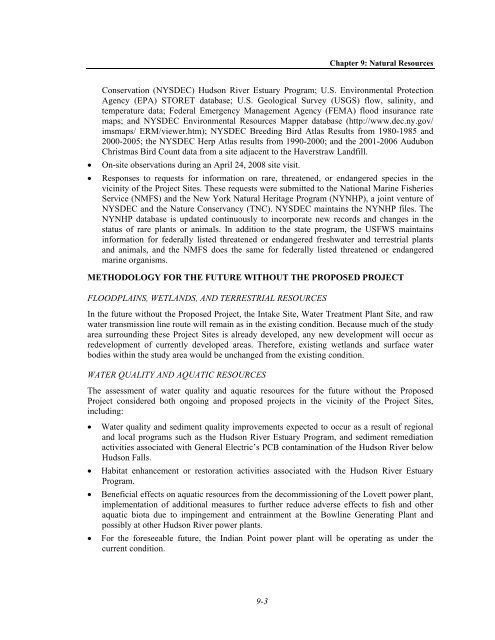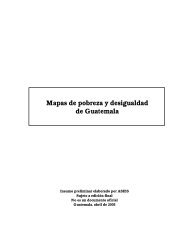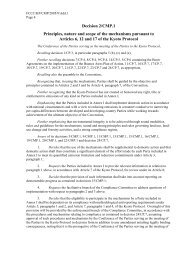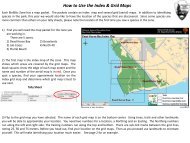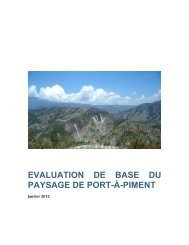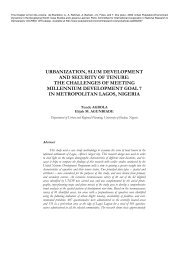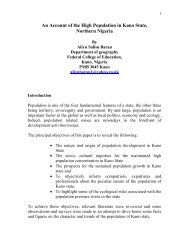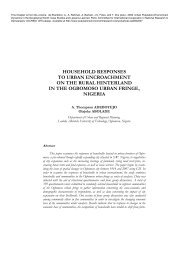<strong>Haverstraw</strong> <strong>Water</strong> <strong>Supply</strong> <strong>Project</strong> <strong>DEIS</strong>the <strong>Haverstraw</strong> Joint Regional Sewage Treatment Plant would not result in significant adverseimpacts to water quality or aquatic biota of the Hudson River. The operation of the Proposed<strong>Project</strong> also would not result in significant adverse impacts to birds and other wildlife using theexisting habitats adjacent to the <strong>Project</strong> Sites.B. METHODOLOGYOVERVIEWThis section presents the methodology used in this chapter to describe natural resources withinthe <strong>Project</strong> Sites under existing and future conditions, and to assess potential impacts on theseresources from the Proposed <strong>Project</strong>.Because the Proposed <strong>Project</strong> would not affect the surrounding terrestrial resources or thefloodplain either directly or indirectly during construction or operation of the intake pumpingstation or water treatment plant, the study area is limited to the boundaries of the <strong>Project</strong> Sites,and their immediate vicinity, including Minisceongo Creek and associated wetlands of theGrassy Point marshes waterfowl winter concentration area. An exception was made for theidentification of threatened or endangered species, which were evaluated for a distance of atleast 0.5 mile from the <strong>Project</strong> Sites. The study area for water quality and aquatic resourcesincluded all of <strong>Haverstraw</strong> Bay and the portion of the Hudson River extending north of<strong>Haverstraw</strong> Bay to Indian Point power plant (approximately one mean flood tide excursion 1 ),and the portion of the Hudson River extending south of <strong>Haverstraw</strong> Bay to about Tappan Zee(approximately one ebb tide excursion).As described in Chapter 2, “<strong>Project</strong> Description,” the Proposed <strong>Project</strong> is being designed todeliver up to 7.5 million gallons per day (mgd) of potable water. When the facility opens foroperation, it would deliver less water, potentially 2.5 mgd to 5 mgd. As Rockland County’spopulation grows and demand increases, the Proposed <strong>Project</strong> would be expanded to meet thatdemand, with the ultimate capacity at 7.5 mgd. Although full operation (i.e., 7.5 mgdproduction) would not occur until some time after 2015, to provide a conservative analysis of theProposed <strong>Project</strong>’s effects on natural resources, the analysis considers the potential effects of fulloperation of the intake, intake pumping station, and water treatment plant to deliver 7.5 mgd ofpotable water by December 2015. Construction is anticipated to start in the spring of 2013.METHODOLOGY FOR EXISTING CONDITIONSExisting conditions for floodplain, water quality, and natural resources within the study areawere summarized from:• Existing information identified in literature and obtained from governmental and nongovernmentalagencies, such as the New York City Department of Environmental Protection(NYCDEP) Harbor <strong>Water</strong> Quality Survey data; U.S. Fish and Wildlife Service (USFWS)National Wetland Inventory maps, federally listed threatened or endangered species forRockland County, New York and Significant Habitats and Habitat Complexes of the NewYork Bight <strong>Water</strong>shed (USFWS 1997); the New York State Department of Environmental1 Tide excursion is the distance traveled by a water parcel during one complete tidal phase, roughly 6.2hours. Mean flood and ebb tide excursions in this portion of the Hudson River are approximately 4 and 7miles, respectively.9-2
Chapter 9: Natural ResourcesConservation (NYSDEC) Hudson River Estuary Program; U.S. Environmental ProtectionAgency (EPA) STORET database; U.S. Geological Survey (USGS) flow, salinity, andtemperature data; Federal Emergency Management Agency (FEMA) flood insurance ratemaps; and NYSDEC Environmental Resources Mapper database (http://www.dec.ny.gov/imsmaps/ ERM/viewer.htm); NYSDEC Breeding Bird Atlas Results from 1980-1985 and2000-2005; the NYSDEC Herp Atlas results from 1990-2000; and the 2001-2006 AudubonChristmas Bird Count data from a site adjacent to the <strong>Haverstraw</strong> Landfill.• On-site observations during an April 24, 2008 site visit.• Responses to requests for information on rare, threatened, or endangered species in thevicinity of the <strong>Project</strong> Sites. These requests were submitted to the National Marine FisheriesService (NMFS) and the New York Natural Heritage Program (NYNHP), a joint venture ofNYSDEC and the Nature Conservancy (TNC). NYSDEC maintains the NYNHP files. TheNYNHP database is updated continuously to incorporate new records and changes in thestatus of rare plants or animals. In addition to the state program, the USFWS maintainsinformation for federally listed threatened or endangered freshwater and terrestrial plantsand animals, and the NMFS does the same for federally listed threatened or endangeredmarine organisms.METHODOLOGY FOR THE FUTURE WITHOUT THE PROPOSED PROJECTFLOODPLAINS, WETLANDS, AND TERRESTRIAL RESOURCESIn the future without the Proposed <strong>Project</strong>, the Intake Site, <strong>Water</strong> Treatment Plant Site, and rawwater transmission line route will remain as in the existing condition. Because much of the studyarea surrounding these <strong>Project</strong> Sites is already developed, any new development will occur asredevelopment of currently developed areas. Therefore, existing wetlands and surface waterbodies within the study area would be unchanged from the existing condition.WATER QUALITY AND AQUATIC RESOURCESThe assessment of water quality and aquatic resources for the future without the Proposed<strong>Project</strong> considered both ongoing and proposed projects in the vicinity of the <strong>Project</strong> Sites,including:• <strong>Water</strong> quality and sediment quality improvements expected to occur as a result of regionaland local programs such as the Hudson River Estuary Program, and sediment remediationactivities associated with General Electric’s PCB contamination of the Hudson River belowHudson Falls.• Habitat enhancement or restoration activities associated with the Hudson River EstuaryProgram.• Beneficial effects on aquatic resources from the decommissioning of the Lovett power plant,implementation of additional measures to further reduce adverse effects to fish and otheraquatic biota due to impingement and entrainment at the Bowline Generating Plant andpossibly at other Hudson River power plants.• For the foreseeable future, the Indian Point power plant will be operating as under thecurrent condition.9-3


